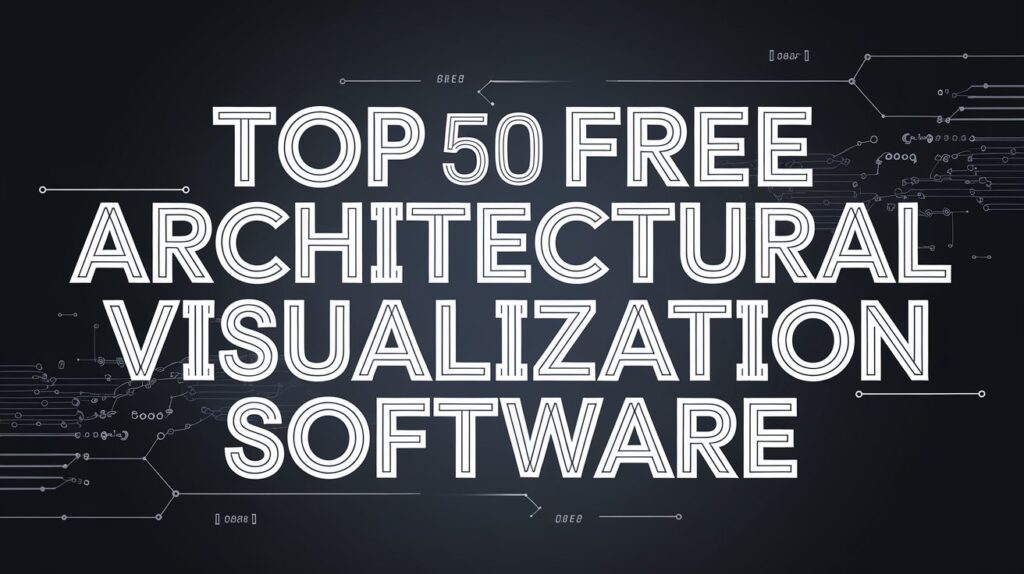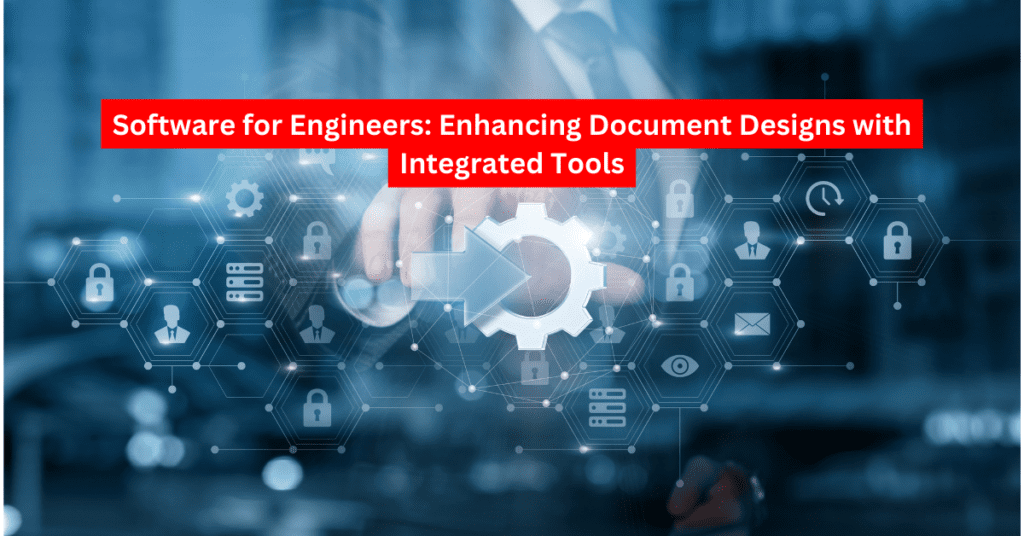In the ever-evolving world of architecture and design, visualization is the key to transforming ideas into reality. Whether you’re a seasoned architect, a budding designer, or a student entering the field, the ability to visualize your concepts is crucial. However, high-end software can be prohibitively expensive. Fortunately, there are a wealth of free architectural visualization tools available that offer powerful features without the hefty price tag. This guide provides a comprehensive review of the top 50 free architectural visualization software, covering everything from 3D modeling and rendering tools to software for creating virtual tours. Let’s dive in.
Table of Contents
Understanding Architectural Visualization
What is Architectural Visualization?
Architectural visualization refers to the process of creating visual representations of architectural designs. This often involves 3D modeling, rendering, and other digital techniques to produce detailed images or animations that convey a design’s appearance before construction begins.
The Importance of Software in Architectural Visualization
Software plays a critical role in architectural visualization, enabling designers to create accurate and visually appealing designs. From intricate 3D models to realistic renderings, the right software allows architects to communicate their ideas effectively and make informed decisions during the design process.
Free vs. Paid Software
While paid software often comes with advanced features and extensive support, free software can be a game-changer, especially for beginners, students, and those working on smaller projects. Free tools provide an excellent starting point for honing skills without financial investment.
Criteria for Selection

Ease of Use
For beginners, a user-friendly interface is essential. The best free software should be easy to learn, with intuitive controls that allow users to focus on creativity rather than struggling with complex commands.
Feature Set
Key features to look for include robust 3D modeling capabilities, rendering options, and compatibility with other design tools. The more features a software offers, the more versatile it becomes for different types of projects.
Community and Support
An active community and available support resources such as tutorials are invaluable, especially when troubleshooting or learning new techniques. Free software with a strong user base often benefits from extensive user-generated content and forums.
Cross-Platform Availability
Software that works across multiple operating systems (Windows, Mac, Linux) offers greater flexibility, ensuring that users can work on their projects regardless of their device.
Integration with Other Tools
Compatibility with other design software, such as AutoCAD or SketchUp, is crucial for a seamless workflow. Free software that integrates well with industry-standard tools allows for smoother project transitions and collaborations.
The Top 50 Free Architectural Visualization Software


3D Modeling Software
- Blender
- Platform: Windows, Mac, Linux
- Key Features: Advanced 3D modeling, sculpting, animation
- Pros: Highly versatile, extensive community support
- Cons: Steeper learning curve
- Best For: Professionals, Students
- Download Link
- FreeCAD
- Platform: Windows, Mac, Linux
- Key Features: Parametric modeling, modular architecture
- Pros: Open-source, customizable
- Cons: Interface can be complex
- Best For: Engineers, Designers
- Download Link
- Tinkercad
- Platform: Web-based
- Key Features: Easy to use, drag-and-drop interface
- Pros: Beginner-friendly, online-based
- Cons: Limited to simpler projects
- Best For: Students, Hobbyists
- Download Link
- SketchUp Free
- Platform: Web-based
- Key Features: Intuitive interface, 3D modeling
- Pros: Accessible, easy to learn
- Cons: Limited features compared to paid versions
- Best For: Beginners, DIY enthusiasts
- Download Link
- Meshmixer
- Platform: Windows, Mac
- Key Features: 3D sculpting, mesh editing
- Pros: Great for modifying existing models
- Cons: Limited compared to full-featured modeling tools
- Best For: Designers needing mesh edits
- Download Link
- Wings 3D
- Platform: Windows, Mac, Linux
- Key Features: Subdivision modeling, customizable interface
- Pros: Simple yet powerful for modeling
- Cons: No built-in rendering engine
- Best For: Modelers focused on subdivision surfaces
- Download Link
- Dust3D
- Platform: Windows, Mac, Linux
- Key Features: Fast model creation, texture mapping
- Pros: Lightweight, fast workflow
- Cons: Limited to basic models
- Best For: Quick 3D model creation
- Download Link
- OpenSCAD
- Platform: Windows, Mac, Linux
- Key Features: Script-based modeling, parametric designs
- Pros: Great for precision models
- Cons: Not user-friendly for those unfamiliar with coding
- Best For: Engineers, parametric design enthusiasts
- Download Link
- Bforartists
- Platform: Windows, Mac, Linux
- Key Features: User-friendly interface, 3D modeling
- Pros: Easier to learn than Blender
- Cons: Still in development, fewer features than Blender
- Best For: Artists needing a user-friendly 3D tool
- Download Link
- LeoCAD
- Platform: Windows, Mac, Linux
- Key Features: LEGO modeling, large part library
- Pros: Fun and educational
- Cons: Limited to LEGO-style models
- Best For: Hobbyists, educators
- Download Link
Rendering Software
- LuxCoreRender
- Platform: Windows, Mac, Linux
- Key Features: Physically based rendering, OpenCL acceleration
- Pros: High-quality rendering, open-source
- Cons: Requires a powerful system
- Best For: Professional Renderers
- Download Link
- Kerkythea
- Platform: Windows, Mac, Linux
- Key Features: Material editor, photo-realistic rendering
- Pros: High-quality output, free material library
- Cons: Less intuitive than some other renderers
- Best For: Architects needing high-quality renders
- Download Link
- POV-Ray
- Platform: Windows, Mac, Linux
- Key Features: Script-based rendering, extensive documentation
- Pros: Highly customizable
- Cons: Script-based, not beginner-friendly
- Best For: Advanced users familiar with scripting
- Download Link
- Mitsuba
- Platform: Windows, Mac, Linux
- Key Features: Spectral rendering, physically based
- Pros: Cutting-edge rendering techniques
- Cons: Complex setup, steep learning curve
- Best For: Researchers, advanced users
- Download Link
- YafaRay
- Platform: Windows, Mac, Linux
- Key Features: Photon mapping, open-source
- Pros: Good integration with Blender
- Cons: Interface can be confusing
- Best For: Blender users needing advanced rendering
- Download Link
- Appleseed
- Platform: Windows, Mac, Linux
- Key Features: Physically based rendering, multi-threading
- Pros: Open-source, active development
- Cons: Still under development, not as polished as other tools
- Best For: Developers, experimental users
- Download Link
- Aqsis
- Platform: Windows, Mac, Linux
- Key Features: RenderMan-compliant renderer, programmable shaders
- Pros: Industry-standard compliance
- Cons: Limited community support
- Best For: Users familiar with RenderMan standards
- Download Link
- RenderMan (Non-Commercial)
- Platform: Windows, Mac, Linux
- Key Features: Pixar-quality rendering, physically based shaders
- Pros: Free for non-commercial use, industry standard
- Cons: Requires a steep learning curve
- Best For: Students, non-commercial projects
- Download Link
- Radeon ProRender
- Platform: Windows, Mac, Linux
- Key Features: GPU-accelerated rendering, physically accurate
- Pros: Cross-platform, supports multiple applications
- Cons: Requires AMD hardware for best performance
- Best For: Users with compatible AMD hardware
- Download Link
- Octane Render Free Tier
- Platform: Windows, Mac
- Key Features: Real-time ray tracing, GPU rendering
- Pros: High-speed, quality output
- Cons: Limited to specific GPUs and software integrations
- Best For: Users with compatible NVIDIA GPUs
- Download Link
Virtual Tour Software
- Twinmotion (Free for Students and Educators)
- Platform: Windows, Mac
- Key Features: Real-time rendering, immersive VR support
- Pros: Intuitive interface, educational license
- Cons: Limited availability for free version
- Best For: Students, educators
- Download Link
- SimLab Composer Lite
- Platform: Windows, Mac
- Key Features: VR creation, real-time rendering
- Pros: Good for beginners, educational purposes
- Cons: Limited features in the free version
- Best For: Students, educators, beginners
- Download Link
- Shapespark
- Platform: Web-based
- Key Features: Interactive 3D walkthroughs, real-time rendering
- Pros: Easy to share and embed online
- Cons: Limited offline capabilities
- Best For: Architects needing web-based presentation tools
- Download Link
- Cupix
- Platform: Web-based
- Key Features: 360-degree tours, cloud-based
- Pros: Cloud storage, collaboration tools
- Cons: Requires internet connection, limited free features
- Best For: Creating virtual tours for presentations
- Download Link
- Pano2VR
- Platform: Windows, Mac, Linux
- Key Features: Create 360-degree panoramic images, virtual tours
- Pros: Feature-rich, customizable
- Cons: Watermarked output in the free version
- Best For: Professionals needing advanced virtual tour tools
- Download Link
- Miro
- Platform: Web-based
- Key Features: Collaborative whiteboard, design collaboration
- Pros: Easy to use, integrates with other tools
- Cons: Limited features in the free version
- Best For: Team collaboration on architectural projects
- Download Link
- Padlet
- Platform: Web-based
- Key Features: Collaborative boards, real-time updates
- Pros: Simple, easy to share
- Cons: Limited storage in free version
- Best For: Quick collaboration and brainstorming
- Download Link
- Trello
- Platform: Web-based
- Key Features: Project management, task tracking
- Pros: Easy to organize and prioritize tasks
- Cons: Limited customization in free version
- Best For: Managing architectural projects and tasks
- Download Link
- Asana
- Platform: Web-based
- Key Features: Project tracking, team collaboration
- Pros: Great for large teams, integrates with other tools
- Cons: Limited features in free version
- Best For: Large teams working on complex projects
- Download Link
- Slack (Free Plan)
- Platform: Web-based, Windows, Mac, Linux, iOS, Android
- Key Features: Team communication, file sharing
- Pros: Real-time messaging, easy file sharing
- Cons: Limited message history in free plan
- Best For: Team communication and collaboration
- Download Link
Collaborative Platforms
Other Visualization Tools
- Inkscape
- Platform: Windows, Mac, Linux
- Key Features: Vector graphics editor, open-source
- Pros: Versatile, supports various formats
- Cons: Not as powerful as commercial vector tools
- Best For: Creating vector-based architectural illustrations
- Download Link
- Sweet Home 3D
- Platform: Windows, Mac, Linux
- Key Features: Interior design, 2D to 3D preview
- Pros: Easy to use, drag-and-drop interface
- Cons: Limited 3D modeling capabilities
- Best For: Interior designers, home planners
- Download Link
- Floorplanner
- Platform: Web-based
- Key Features: Floor plan design, 3D visualization
- Pros: Simple, web-based
- Cons: Limited features in free version
- Best For: Quick floor plan creation
- Download Link
- Planner 5D
- Platform: Web-based, iOS, Android
- Key Features: Home design, 3D visualization
- Pros: Mobile support, easy to use
- Cons: Limited objects in free version
- Best For: Homeowners planning renovations
- Download Link
- Roomstyler 3D Home Planner
- Platform: Web-based
- Key Features: Interior design, 3D visualization
- Pros: Easy to use, web-based
- Cons: Limited customization
- Best For: Interior designers, hobbyists
- Download Link
- MyVirtualHome
- Platform: Windows
- Key Features: Home design, 3D walkthroughs
- Pros: User-friendly, detailed outputs
- Cons: Limited to home design
- Best For: Homeowners planning renovations
- Download Link
- Live Home 3D (Free Version)
- Platform: Windows, Mac, iOS
- Key Features: Home design, 3D rendering
- Pros: Cross-platform, user-friendly
- Cons: Limited features in the free version
- Best For: Home design enthusiasts
- Download Link
- SmartDraw (Free for Education)
- Platform: Web-based, Windows
- Key Features: Floor plans, flowcharts, diagrams
- Pros: Easy to create professional diagrams
- Cons: Limited to educational use for free version
- Best For: Students, educators
- Download Link
- LibreCAD
- Platform: Windows, Mac, Linux
- Key Features: 2D CAD, open-source
- Pros: Lightweight, easy to use
- Cons: Limited to 2D designs
- Best For: 2D architectural drafting
- Download Link
- DraftSight (Free Version)
- Platform: Windows, Mac, Linux
- Key Features: 2D CAD, DWG file support
- Pros: Familiar interface for AutoCAD users
- Cons: Limited features in free version
- Best For: Professionals familiar with AutoCAD
- Download Link
Animation and Simulation Software
Sketchfab
Platform: Web-based
Key Features: 3D model viewer, animations, VR support
Pros: Easy to embed models, supports VR
Cons: Limited uploads in free version
Best For: Sharing 3D models and animations
Unity Personal
Platform: Windows, Mac
Key Features: Game development, real-time rendering
Pros: Extensive features, active community
Cons: Complex interface
Best For: Architects exploring VR and interactive projects
Unreal Engine (Free Version)
Platform: Windows, Mac
Key Features: Game development, real-time rendering
Pros: High-quality output, strong community support
Cons: Steeper learning curve
Best For: High-end visualization, VR projects
Synfig Studio
Platform: Windows, Mac, Linux
Key Features: 2D animation, open-source
Pros: Great for creating 2D animations
Cons: Lacks advanced 3D features
Best For: 2D architectural animations
K-3D
Platform: Windows, Mac, Linux
Key Features: 3D modeling, animation
Pros: Open-source, flexible
Cons: Steep learning curve
Best For: Animators needing a free 3D tool
Clara.io
Platform: Web-based
Key Features: 3D modeling, animation, cloud-based
Pros: No installation needed, easy to share
Cons: Requires a stable internet connection
Best For: Simple animations, collaborative projects
Blender (Again, for its Animation Tools)
Platform: Windows, Mac, Linux
Key Features: Advanced 3D modeling, animation, VFX
Pros: Industry-standard for animation
Cons: Steep learning curve
Best For: Professional 3D animators
MakeHuman
Platform: Windows, Mac, Linux
Key Features: Character modeling, rigging
Pros: Easy to create realistic characters
Cons: Limited to character creation
Best For: Adding human figures to architectural visualizations
Pencil2D
Platform: Windows, Mac, Linux
Key Features: 2D animation, hand-drawn effects
Pros: Simple, beginner-friendly
Cons: Limited to 2D animations
Best For: Sketching and simple animations
Natron
Platform: Windows, Mac, Linux
Key Features: Compositing, visual effects
Pros: Open-source, powerful node-based workflow
Cons: Steeper learning curve for beginners
Best For: Compositing and VFX in architectural animations
How to Choose the Right Software for Your Needs
Assessing Your Requirements
Determine what you need based on the type of project, your skill level, and your hardware capabilities. Beginners might prioritize ease of use, while professionals may focus on advanced features and rendering quality.
Combining Multiple Tools
Often, using a combination of software can yield the best results. For example, you might use Blender for 3D modeling and LuxCoreRender for rendering. Understanding how different tools can complement each other will enhance your workflow.
Future-Proofing Your Skills
Choose software that helps you learn transferable skills. This will ensure that as you progress, your expertise remains relevant, even if you transition to paid tools in the future.
Tips for Getting the Most Out of Free Software
Leverage Online Tutorials
There are countless online tutorials available for almost every free architectural visualization tool. Make the most of these resources to improve your skills and master the software.
Join User Communities
Being part of a user community can be immensely beneficial. It allows you to exchange tips, solve problems, and stay updated on the latest developments and best practices.
Regular Updates and Improvements
Keep your software up-to-date to benefit from new features, performance enhancements, and security patches. Regular updates often add new functionalities and improve the overall user experience.
Frequently Asked Questions (FAQs)
What is architectural visualization?
Architectural visualization is the process of creating visual representations of architectural designs, often in 3D, to communicate ideas before construction begins.
Is free architectural visualization software reliable?
Yes, many free tools offer reliable and powerful features, though they may lack the advanced capabilities of paid software. They are especially useful for beginners, students, and small projects.
Which software is best for beginners?
Software like Tinkercad and Sweet Home 3D are ideal for beginners due to their user-friendly interfaces and simple learning curves.
Can I use multiple software tools together?
Absolutely. Many professionals use a combination of tools to take advantage of different features, such as using Blender for 3D modeling and LuxCoreRender for rendering.
What are the system requirements for most of these software?
The requirements vary, but most free tools are designed to be accessible on a wide range of hardware. Check the specific requirements on the software’s download page.
How often should I update my software?
It’s recommended to update regularly to benefit from new features, security patches, and performance improvements.
Conclusion


Free architectural visualization software offers immense value, providing powerful tools for designers of all levels without any financial investment. By experimenting with different software, you can find the tools that best suit your needs and help bring your architectural visions to life. Remember, while software is important, understanding the fundamentals of architectural visualization will always be the key to creating stunning designs.
Call to Action: What’s your go-to free architectural visualization software? Share your thoughts in the comments below!


